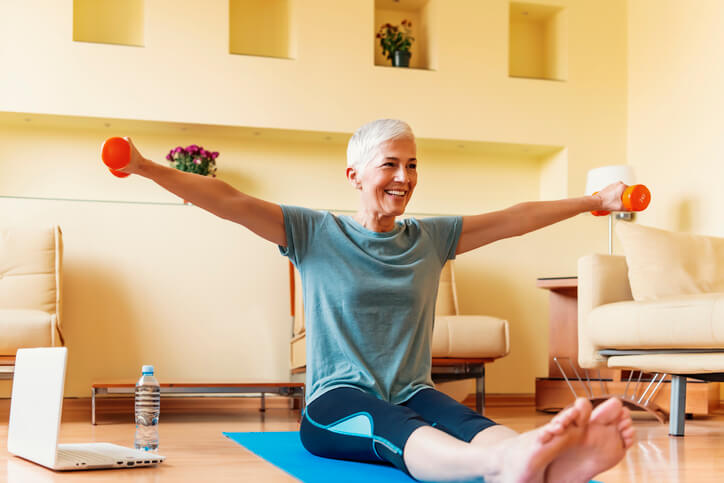How Balance Exercises Can Help Seniors Prevent Falls
- Accidental falls are the main cause of injuries among Americans over the age of 65. Learn how balance exercises for seniors can help reduce the risk of falls.

People of all ages can lose their balance and fall, but the risk of taking a tumble increases with age. While falls among older adults are a serious health concern, studies show that regular physical activity, including balance exercises for seniors, can help prevent accidents.
Falls are the main cause of injuries among Americans over the age of 65, sometimes leading to broken bones, hip fractures and head injuries. One-quarter of older adults fall each year, according to the U.S. Centers for Disease Control and Prevention (CDC).
Here’s a look at the importance of balance training for older adults, and some examples to get you started at home.
Balance Exercises for Seniors to Try at Home
Exercise classes for seniors offer benefits such as professional instruction and socialization, but you can also incorporate a few simple balance exercises into your routine at home.
Before You Begin
Hold onto the back of a chair, countertop or wall when starting these exercises.
- As you get stronger, progress from supporting yourself with both hands to using one hand.
- When you're comfortable, use just your fingertips for support.
- Always have a wall or chair nearby to steady yourself if needed, even if you can do the exercises on your own.
Balance for a few seconds to start.
- As your stability improves, progress to balancing for longer.
- Repeat each exercise up to 10 times or as many times as you're able.
- If you need more of a challenge, close your eyes when balancing.
Tiptoe Stand
- Stand with your feet together.
- Lift yourself onto your tiptoes.
- Stand tall and balance.
- Slowly lower your heels back to the floor.
Single Leg Stand
- Stand with your feet hip width apart and weight evenly distributed.
- Lift your right foot a few inches off the floor, bending slightly at the knee.
- Balance.
- Lower your right foot back to the floor.
- Lift your left foot and repeat.
Kickbacks
- Stand with your feet hip width apart.
- Bend your right knee slowly, so the back of your right heel points toward the ceiling.
- Balance.
- Slowly lower your right foot back to the floor.
- Repeat with your left leg.
Side Leg Raises
- Stand with your feet hip width apart.
- Slowly lift your right leg to the side about 6 to 12 inches. Make sure your back is straight and your toes are pointed forward.
- Balance.
- Lower your right leg back to the ground.
- Repeat with your left leg.
Standing Balance
- Stand with your feet together.
- Step forward and place your right foot a few inches in front of your left foot, as if on a tightrope. If this is difficult, you can keep your feet further apart, but the goal is to have as narrow a stance as possible.
- Balance.
- Return to original position.
- Step forward and repeat with your left foot.
Heel to Toe Walk
This exercise requires enough clear space for you to walk. A hallway with a wall that you can use for support is ideal.
- Holding your arms to the side for balance, take a step forward with your right foot.
- Place your right heel in front of the toes of your left foot so they're almost touching, as if you're on a tightrope.
- Take a step forward with your left foot and repeat.
- Walk for 20 steps or as far as you're able.
If this is difficult, place your foot slightly to the side of the other when you step, instead of directly in front.
Why Are Older Adults at Risk of Falling?
A slippery bathtub, uneven pavement or patch of ice can cause a fall no matter how old you are. However, some factors increase the risk among older adults.
- Vision problems may make it difficult to judge distance and depth.
- Decline in function of the ear can affect equilibrium and balance.
- Weakness caused by chronic illness or physical inactivity impacts reflexes and coordination.
- Discomfort from pain can reduce mobility.
- Medication can cause dizziness and light-headedness.
One out of five falls causes a serious injury such as a broken wrist, fractured hip or head injury, according to the CDC. Some seniors also become scared of falling again and may limit their activities, leading to depression or social isolation.
Can Exercise Improve Your Balance?
To decrease the risk of falls, the CDC recommends that seniors strengthen their balance by regularly engaging in exercises, such as standing on one leg.
Balance training should be part of a multicomponent exercise routine that includes aerobic activity and strength training. Good physical health, including strong bones and muscles, flexibility and coordination, helps keep you steady on your feet and reduces the chance of injury from a fall.
Benefits of Tai Chi for Seniors
One of the best balance exercises for seniors to prevent falls is tai chi. This low-impact activity involves a series of movements performed while standing, focusing on leg strength and range of motion.
According to a report on the Harvard Health blog, tai chi reduces falls among older adults by 45% and improves stability among those with neurological conditions, such as Parkinson’s disease.
Senior centers, community centers and gyms, such as the YMCA, often offer tai chi classes. Group exercise programs such as yoga can also help with balance and flexibility.
Additional Resources
The National Council on Aging works with community partners to provide evidenced-based fall prevention programs and resources to keep seniors safe and active.
These programs aim to reduce falls through exercise to improve balance, education, home modification and other support. Visit their website to find a fall prevention program near you.



